新课标七年级英语下册第十单元全单元教案
- 格式:doc
- 大小:81.00 KB
- 文档页数:10
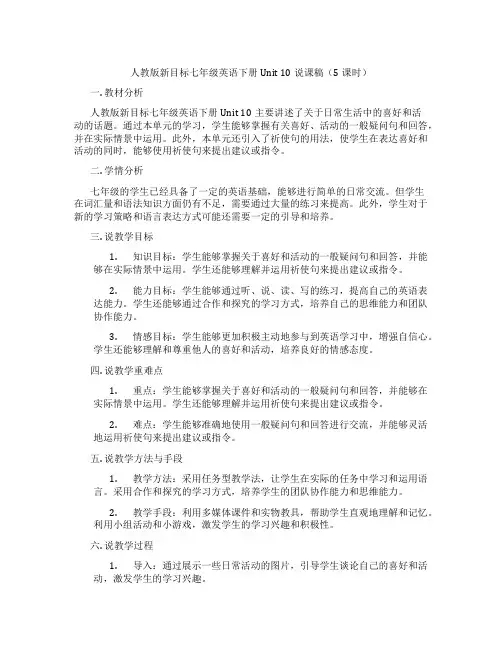
人教版新目标七年级英语下册 Unit 10说课稿(5课时)一. 教材分析人教版新目标七年级英语下册Unit 10主要讲述了关于日常生活中的喜好和活动的话题。
通过本单元的学习,学生能够掌握有关喜好、活动的一般疑问句和回答,并在实际情景中运用。
此外,本单元还引入了祈使句的用法,使学生在表达喜好和活动的同时,能够使用祈使句来提出建议或指令。
二. 学情分析七年级的学生已经具备了一定的英语基础,能够进行简单的日常交流。
但学生在词汇量和语法知识方面仍有不足,需要通过大量的练习来提高。
此外,学生对于新的学习策略和语言表达方式可能还需要一定的引导和培养。
三. 说教学目标1.知识目标:学生能够掌握关于喜好和活动的一般疑问句和回答,并能够在实际情景中运用。
学生还能够理解并运用祈使句来提出建议或指令。
2.能力目标:学生能够通过听、说、读、写的练习,提高自己的英语表达能力。
学生还能够通过合作和探究的学习方式,培养自己的思维能力和团队协作能力。
3.情感目标:学生能够更加积极主动地参与到英语学习中,增强自信心。
学生还能够理解和尊重他人的喜好和活动,培养良好的情感态度。
四. 说教学重难点1.重点:学生能够掌握关于喜好和活动的一般疑问句和回答,并能够在实际情景中运用。
学生还能够理解并运用祈使句来提出建议或指令。
2.难点:学生能够准确地使用一般疑问句和回答进行交流,并能够灵活地运用祈使句来提出建议或指令。
五. 说教学方法与手段1.教学方法:采用任务型教学法,让学生在实际的任务中学习和运用语言。
采用合作和探究的学习方式,培养学生的团队协作能力和思维能力。
2.教学手段:利用多媒体课件和实物教具,帮助学生直观地理解和记忆。
利用小组活动和小游戏,激发学生的学习兴趣和积极性。
六. 说教学过程1.导入:通过展示一些日常活动的图片,引导学生谈论自己的喜好和活动,激发学生的学习兴趣。
2.呈现:通过多媒体课件展示本节课的主要内容,让学生整体感知和理解。
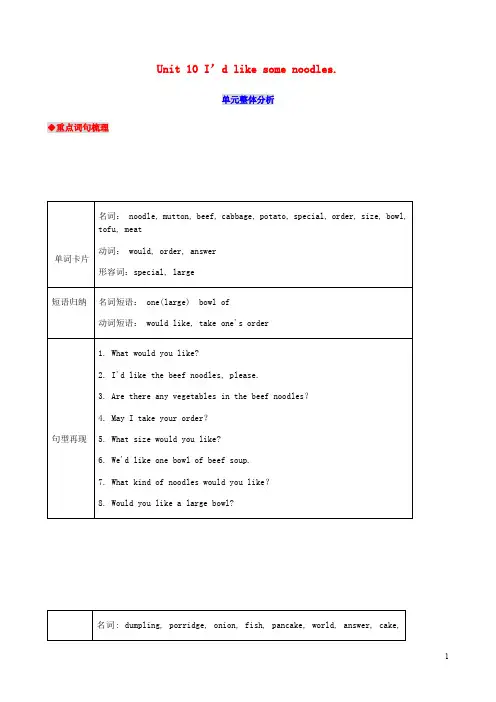
Unit 10 I’d like some noodles.单元整体分析◆重点词句梳理◆教材内容解本单元的中心话题是“就餐”。
Section A部分有三个方面的内容:一是有关食品的词汇mutton, beef, noodles, chicken, cabbage, potato, tomato, carrot等;二是食品名词中的可数名词与不可数名词的用法;三是订餐或叫外卖等的用语。
Section B部分重点是关于订餐的主题内容和语言表达。
通过打电话订餐的情境,让学生感悟订餐时所用句型结构。
阅读篇章通过对全世界各种各样的生日食品的介绍,了解世界各地的饮食文化,生日文化等事情,使学生们具有初步的世界文化观念。
◆功能话题应用What kind of noodles would you like?I’d like beef and tomato noodles, please.What size would you like?I’d like a small/ medium/ large bowl.Would you like any drinks?One large green tea.◆语法结构点击1. would like的用法2. some与any的用法3. 可数名词与不可数名词的用法背景知识链接◆The history of pizza比萨饼是意大利人发明的吗?Italian pizza is very famous. Many people think that pizza comes from Italy, but it is wrong. The first pizza didn’t appear (出现) in Italy.Long long ago, the early Greeks first made large, round and flat (扁平的) bread. When they made the bread, they put many things over the bread, such as tomatoes, potatoes, meat and other things. Their bread tasted (尝起来) very good.Later, the idea of flat bread found its way to Italy. In the 18th century, Italian people called the flat bread “pizza”. They sold it on the streets and at the markets. Pizza was very cheap. Many people liked it.Now pizza is very popular around the world. It tastes better and better.Section A新课备课素材◆素材一新课导入设计导入一图片导入: show some pictures about food, meat and vegetables; Then ask and answer: What's your favorite food/drink/vegetables? Lead to the new words and sentences with the pictures; then lead to the new lesson.导入二Pandora's box: The teacher prepare a box and write these words :food, meat, vegetables and drink on some pieces of paper. Then put them into the box. Ss extract a card and say the导入三Brainstorming: Write down the words as many as possible about food, meat and vegetables; And then lead to the new lesson.◆素材二新课活动案例活动 1 : Which restaurant is the most special?If you have a special restaurant, please make a menu yourself.Then show your menu to other Ss.活动 2:Who is the fastest?(详见PPT)活动 3 Role-play(分角色表演,学生分组模拟餐馆场景编演对话。
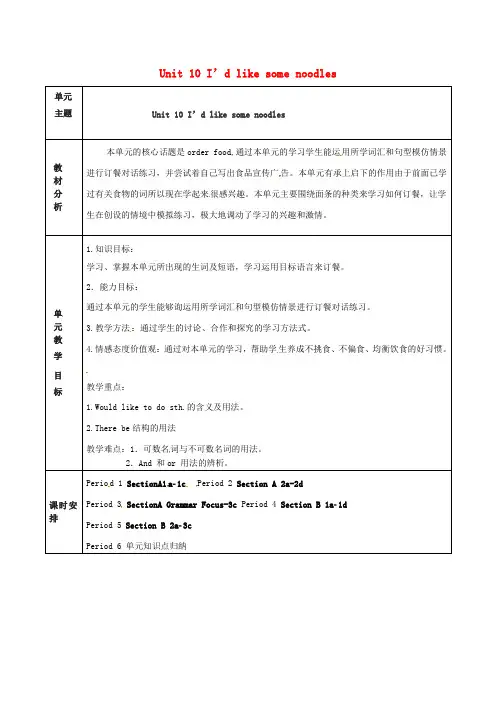
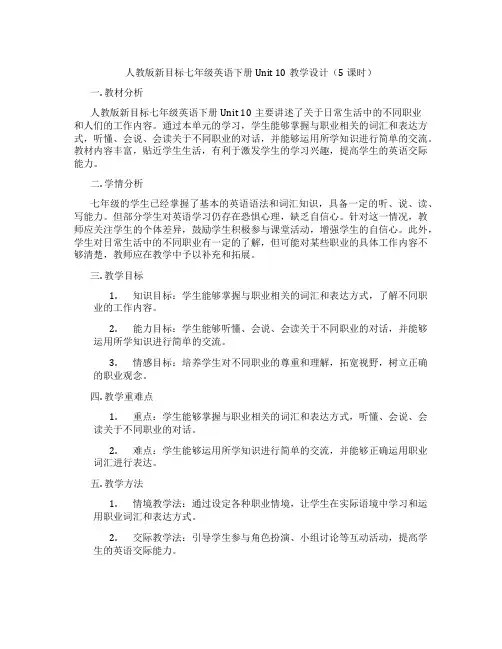
人教版新目标七年级英语下册 Unit 10教学设计(5课时)一. 教材分析人教版新目标七年级英语下册Unit 10主要讲述了关于日常生活中的不同职业和人们的工作内容。
通过本单元的学习,学生能够掌握与职业相关的词汇和表达方式,听懂、会说、会读关于不同职业的对话,并能够运用所学知识进行简单的交流。
教材内容丰富,贴近学生生活,有利于激发学生的学习兴趣,提高学生的英语交际能力。
二. 学情分析七年级的学生已经掌握了基本的英语语法和词汇知识,具备一定的听、说、读、写能力。
但部分学生对英语学习仍存在恐惧心理,缺乏自信心。
针对这一情况,教师应关注学生的个体差异,鼓励学生积极参与课堂活动,增强学生的自信心。
此外,学生对日常生活中的不同职业有一定的了解,但可能对某些职业的具体工作内容不够清楚,教师应在教学中予以补充和拓展。
三. 教学目标1.知识目标:学生能够掌握与职业相关的词汇和表达方式,了解不同职业的工作内容。
2.能力目标:学生能够听懂、会说、会读关于不同职业的对话,并能够运用所学知识进行简单的交流。
3.情感目标:培养学生对不同职业的尊重和理解,拓宽视野,树立正确的职业观念。
四. 教学重难点1.重点:学生能够掌握与职业相关的词汇和表达方式,听懂、会说、会读关于不同职业的对话。
2.难点:学生能够运用所学知识进行简单的交流,并能够正确运用职业词汇进行表达。
五. 教学方法1.情境教学法:通过设定各种职业情境,让学生在实际语境中学习和运用职业词汇和表达方式。
2.交际教学法:引导学生参与角色扮演、小组讨论等互动活动,提高学生的英语交际能力。
3.任务型教学法:布置相关职业的调查任务,让学生在完成任务的过程中,巩固和拓展所学知识。
六. 教学准备1.教学课件:制作含有不同职业图片、词汇和对话的课件,以便在课堂上进行展示和教学。
2.教学素材:准备与职业相关的图片、视频等素材,丰富教学内容,提高学生的学习兴趣。
3.调查问卷:设计一份关于学生家长职业的调查问卷,以便在课堂上进行调查和交流。
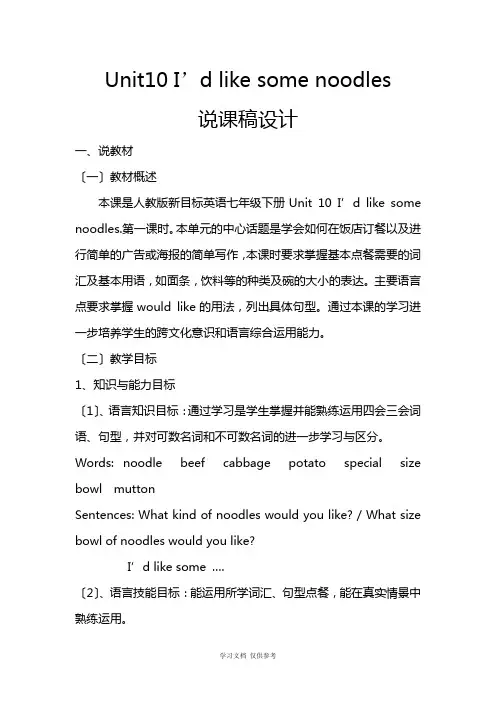
Unit10 I’d like some noodles说课稿设计一、说教材〔一〕教材概述本课是人教版新目标英语七年级下册Unit 10 I’d like some noodles.第一课时。
本单元的中心话题是学会如何在饭店订餐以及进行简单的广告或海报的简单写作,本课时要求掌握基本点餐需要的词汇及基本用语,如面条,饮料等的种类及碗的大小的表达。
主要语言点要求掌握would like的用法,列出具体句型。
通过本课的学习进一步培养学生的跨文化意识和语言综合运用能力。
〔二〕教学目标1、知识与能力目标〔1〕、语言知识目标:通过学习是学生掌握并能熟练运用四会三会词语、句型,并对可数名词和不可数名词的进一步学习与区分。
Words: noodle beef cabbage potato special size bowl muttonSentences: What kind of noodles would you like? / What size bowl of noodles would you like?I’d like some ….〔2〕、语言技能目标:能运用所学词汇、句型点餐,能在真实情景中熟练运用。
2、过程与方法目标:培养学生自主学习的能力、语言综合运用能力、听力、英语会话能力、与他人合作的能力。
3、情感态度与价值观目标:通过创设真实的点餐情景,让学生身临其境感受和体验,使语言学以致用,做到“在用中学,在学中用”,激发学生的学习积极性。
体会在活动中学习英语的乐趣。
培养学生乐于与他人合作的精神及养成科学的饮食习惯。
4、文化意识目标:通过对中、西方在饮食及用餐方面异同的比照,对祖国饮食文化能有更深刻的了解。
乐于了解异国文化,加强对文化差异的理解与认识。
5、学习策略目标:通过学习,使学生在一定程度上形成自主学习、探究学习、合作学习的习惯,有效培养学生的英语思维能力。
〔三〕、教学重点与难点重点:1、学习日常生活中有关食物的名称。

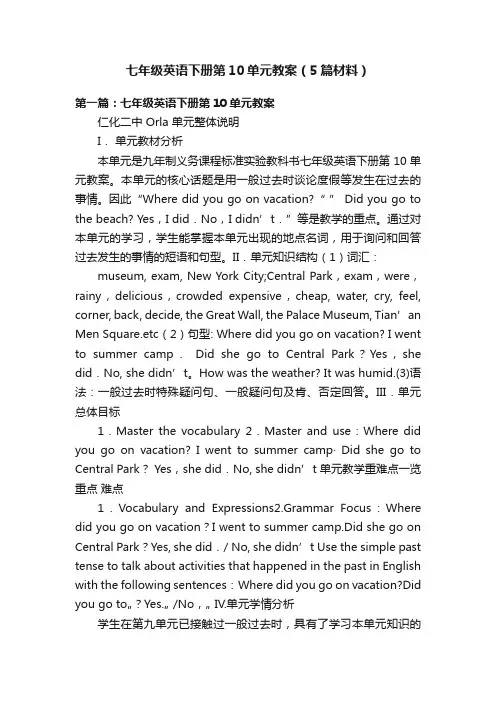
七年级英语下册第10单元教案(5篇材料)第一篇:七年级英语下册第10单元教案仁化二中 Orla 单元整体说明I.单元教材分析本单元是九年制义务课程标准实验教科书七年级英语下册第10单元教案。
本单元的核心话题是用一般过去时谈论度假等发生在过去的事情。
因此“Where did you go on vacation?“ ” Did you go to the beach? Yes,I did.No,I didn’t.”等是教学的重点。
通过对本单元的学习,学生能掌握本单元出现的地点名词,用于询问和回答过去发生的事情的短语和句型。
II.单元知识结构(1)词汇:museum, exam, New York City;Central Park,exam,were,rainy,delicious,crowded expensive,cheap, water, cry, feel, corner, back, decide, the Great Wall, the Pal ace Museum, Tian’an Men Square.etc(2)句型: Where did you go on vacation? I went to summer camp.Did she go to Central Park?Yes,she did.No, she didn’t。
How was the weather? It was humid.(3)语法:一般过去时特殊疑问句、一般疑问句及肯、否定回答。
III.单元总体目标1.Master the vocabulary 2.Master and use:Where did you go on vacation? I went to summer camp· Did she go to Central Park? Yes,she did.No, she didn’t 单元教学重难点一览重点难点1.Vocabulary and Expressions2.Grammar Focus:Where did you go on vacation?I went to summer camp.Did she go on Central Park?Yes, she did./ No, she didn’t Use the simple past tense to talk about activities that happened in the past in English with the following sentences:Where did you go on vacation?Did you go to…?Yes.… /No,… IV.单元学情分析学生在第九单元已接触过一般过去时,具有了学习本单元知识的认知前提,能自然地与本单元话题进行衔接。
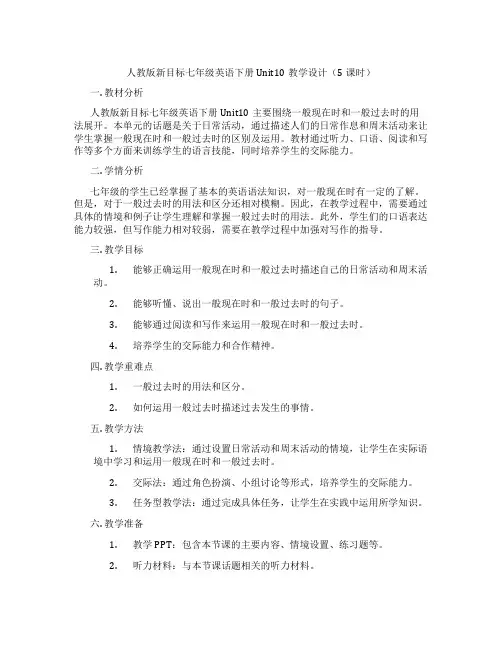
人教版新目标七年级英语下册 Unit10教学设计(5课时)一. 教材分析人教版新目标七年级英语下册Unit10主要围绕一般现在时和一般过去时的用法展开。
本单元的话题是关于日常活动,通过描述人们的日常作息和周末活动来让学生掌握一般现在时和一般过去时的区别及运用。
教材通过听力、口语、阅读和写作等多个方面来训练学生的语言技能,同时培养学生的交际能力。
二. 学情分析七年级的学生已经掌握了基本的英语语法知识,对一般现在时有一定的了解。
但是,对于一般过去时的用法和区分还相对模糊。
因此,在教学过程中,需要通过具体的情境和例子让学生理解和掌握一般过去时的用法。
此外,学生们的口语表达能力较强,但写作能力相对较弱,需要在教学过程中加强对写作的指导。
三. 教学目标1.能够正确运用一般现在时和一般过去时描述自己的日常活动和周末活动。
2.能够听懂、说出一般现在时和一般过去时的句子。
3.能够通过阅读和写作来运用一般现在时和一般过去时。
4.培养学生的交际能力和合作精神。
四. 教学重难点1.一般过去时的用法和区分。
2.如何运用一般过去时描述过去发生的事情。
五. 教学方法1.情境教学法:通过设置日常活动和周末活动的情境,让学生在实际语境中学习和运用一般现在时和一般过去时。
2.交际法:通过角色扮演、小组讨论等形式,培养学生的交际能力。
3.任务型教学法:通过完成具体任务,让学生在实践中运用所学知识。
六. 教学准备1.教学PPT:包含本节课的主要内容、情境设置、练习题等。
2.听力材料:与本节课话题相关的听力材料。
3.图片素材:与日常活动和周末活动相关的图片。
4.作业素材:相关练习题和写作题目。
七. 教学过程1.导入(5分钟)利用图片和简单的提问方式引入本节课的话题,激发学生的兴趣。
2.呈现(10分钟)通过PPT展示本节课的主要内容,包括一般过去时的定义、用法和标志性词语。
同时,结合情境展示如何运用一般过去时描述过去发生的事情。
3.操练(15分钟)让学生进行听力练习,听懂一般过去时的句子,并模仿发音。
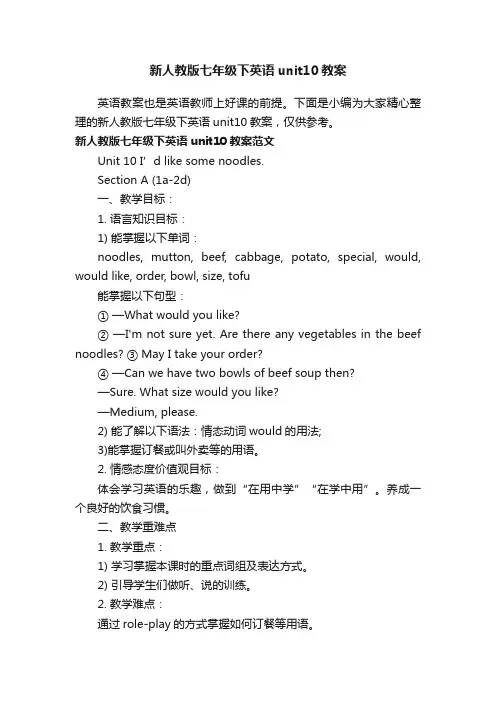
新人教版七年级下英语unit10教案英语教案也是英语教师上好课的前提。
下面是小编为大家精心整理的新人教版七年级下英语unit10教案,仅供参考。
新人教版七年级下英语unit10教案范文Unit 10 I’d like some noodles.Section A (1a-2d)一、教学目标:1. 语言知识目标:1) 能掌握以下单词:noodles, mutton, beef, cabbage, potato, special, would, would like, order, bowl, size, tofu能掌握以下句型:① —What would you like?② —I'm not sure yet. Are there any vegetables in the beef noodles? ③ May I take your order?④ —Can we have two bowls of beef soup then?—Sure. What size would you like?—Medium, please.2) 能了解以下语法:情态动词would的用法;3)能掌握订餐或叫外卖等的用语。
2. 情感态度价值观目标:体会学习英语的乐趣,做到“在用中学”“在学中用”。
养成一个良好的饮食习惯。
二、教学重难点1. 教学重点:1) 学习掌握本课时的重点词组及表达方式。
2) 引导学生们做听、说的训练。
2. 教学难点:通过role-play的方式掌握如何订餐等用语。
三、教学过程Ⅰ. Warming-up and lead in1. Watch a video program about food and vegetables.2. Ask and answer: What's your favorite food/drink/vegetables?Ⅱ. Presentation1. (show some pictures of food on the big screen)Present some new words and expressions to the Ss.2. Ss learn the new words and expressions by themselves and try to remember them.3. Work on 1a:Read the words on the left and look at the pictures on the right. Write the letters ofthe food on the line. Then check the answers.Ⅲ. Game (Guess the food.)(Show some pictures of food on the big screen)Let Ss guess what food it is.Ss try to guess the food and learn the words.Ⅳ. ListeningT: In the following conversation, one man is ordering some food. Now, let’s listen to the tape, find out the right nood les the person orders.Play the recording for the Ss to listen and check the answers.Ⅴ. Pair work1. Present the conversation in 1b on the big screen and ask Ss to practice it.2. Make their own conversations using the noodles in the picture.3. Let some pairs act out their conversations.Ⅵ. Listening1. Work on 2a;T: Now, look at the pictures on the right, listen to the conversations and check the names of the foods you hear.(Play the recording for the first time, students only listen carefully.Then, listen to the recording again, and check the names of the foods.Check the answers. )2. Work on 2b:(Play the recording for the Ss to listen and complete the sentences.)Play the recording twice. The first time Ss just listen. And the second time, Sslisten and write down the words.(If necessary, use the pause button to help Ss)3. Check the answers.Ⅶ. Pair work1. Ask and answer questions with your partner. Use the information in 2a.2. Show the conversations of 2a on the big screen to the Ss.3. Make a model for the Ss.T: What kind of noodles would you like?S1: I'd like beef noodles, please.…3. Ss work in pairs and practice the conversations.Ⅷ. Role-play1. Ask Ss to read the conversation in 2d and find the answer to this question: What would they like?(They would like one large bowl of beef soup, one gongbao chicken, and onemapo tofu with rice.)2. Check the answers with the Ss.3. Ss work with their partners and role-play the conversation.VIII. Language pointsIX. ExercisesHomework1. Review the words and expressions in this period.2. Role-play the conversation in 2d.3. Write a short conversation to order some noodles you like in a restaurant.七年级英语考试拿高分必背美文——爱美The love of beauty is an essential part of all healthy human nature. It is a moral quality. The absence of it is not an assured ground of condemnation, but the presence of it is an invariable sign of goodness of heart. In proportion to the degree in which it is felt will probably be the degree in which nobleness and beauty of character will be attained.Natural beauty is an all-pervading presence. The universe is its temple. It unfolds into the numberless flowers of spring. It waves in the branches of trees and the green blades of grass. It haunts the depths of the earth and the sea. It gleams from the hues of the shell and the precious stone. And not only these minute objects but the oceans, the mountains, the clouds, the stars, the rising and the setting sun---all overflow with beauty. This beauty is so precious, and so congenial to our tenderest and noblest feelings, that it is painful to think of the multitude of people living in the midst of it and yet remaining almost blind to it.All persons should seek to become acquainted with the beauty in nature. There is not a worm we tread upon, nor a leafthat dances merrily as it falls before the autumn winds, but calls for our study and admiration. The power to appreciated beauty not merely increases our sources of happiness---it enlarges our moral nature, too. Beauty calms our restlessness and dispels our cares. Go into the fields or the woods, spend a summer day by the sea or the mountains, and all your little perplexities and anxieties will vanish. Listen to sweet music, and your foolish fears and petty jealousies will pass away. The beauty of the world helps us to seek and find the beauty of goodness.译文:爱美爱美及是整个健全人性不可或缺之一部分。
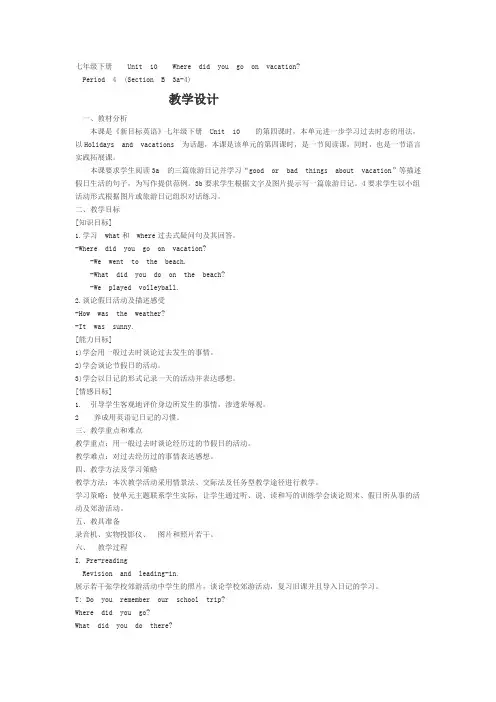
七年级下册Unit 10 Where did you go on vacation?Period 4 (Section B 3a-4)教学设计一、教材分析本课是《新目标英语》七年级下册Unit 10 的第四课时,本单元进一步学习过去时态的用法,以Holidays and vacations 为话题,本课是该单元的第四课时,是一节阅读课,同时,也是一节语言实践拓展课。
本课要求学生阅读3a 的三篇旅游日记并学习“good or bad things about vacation”等描述假日生活的句子,为写作提供范例。
3b要求学生根据文字及图片提示写一篇旅游日记。
4要求学生以小组活动形式根据图片或旅游日记组织对话练习。
二、教学目标[知识目标]1.学习what和where过去式疑问句及其回答。
-Where did you go on vacation?-We went to the beach.-What did you do on the beach?-We played volleyball.2.谈论假日活动及描述感受-How was the weather?-It was sunny.[能力目标]1)学会用一般过去时谈论过去发生的事情。
2)学会谈论节假日的活动。
3)学会以日记的形式记录一天的活动并表达感想。
[情感目标]1. 引导学生客观地评价身边所发生的事情,渗透荣辱观。
2 养成用英语记日记的习惯。
三、教学重点和难点教学重点:用一般过去时谈论经历过的节假日的活动。
教学难点:对过去经历过的事情表达感想。
四、教学方法及学习策略教学方法:本次教学活动采用情景法、交际法及任务型教学途径进行教学。
学习策略:使单元主题联系学生实际,让学生通过听、说、读和写的训练学会谈论周末、假日所从事的活动及郊游活动。
五、教具准备录音机、实物投影仪、图片和照片若干。
六、教学过程I. Pre-readingRevision and leading-in.展示若干张学校郊游活动中学生的照片,谈论学校郊游活动,复习旧课并且导入日记的学习。
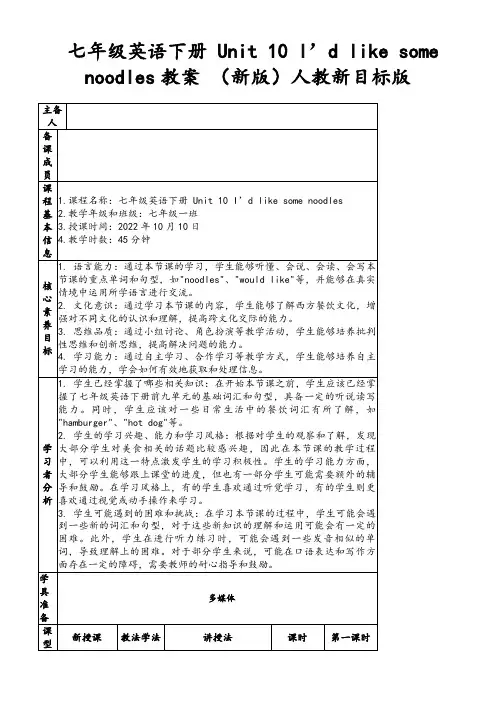
Unit 10 I’d like some noodles. 想要在牛肉面里一碗面条两碗面条一大碗….. 一中碗……一小碗….. 你可以点餐了吗?在羊肉汤里宫保鸡丁麻婆豆腐和饭哪种面条土豆沙拉西红柿蛋饭牛肉胡萝卜面全世界想要吃在某人生日时在不同的国家吃加蜡烛的生日蛋糕蜡烛的数量许多、大量人的年龄许愿吹灭蜡烛一次性地实现有糖的孩子受欢迎切碎长寿的象征生活和好运的象征给…..带来好运一大碗卖四元would like in the beef noodles a bowl of noodles two bowls of noodles a large bowl of a medium bowl of a small bowl of May I take your order?in the mutton soup gongbao chichen mapo tofu with rice what kind of noodles potato salad tomato and egg rice beef and carrot noodles(beef noodles with carrots)around the world( all over the world ) would like to eaton one’s birthday in different countrieshave birthday cakes with candlesthe number of candles a number ofthe person’s age make a wish blow out the candles in one go come true the child with the candy get popular cut up a symbol of long lifea symbol of life and good luck bring good luck toa big bowl for four yuan。
七年级下英语unit10优秀教案一、教学目标1. 知识目标:学生能够掌握本单元的词汇和主要句型,如“What are you going to do for vacation? I’m going to visit my aunt in Canada.”。
2. 能力目标:学生能够运用所学知识进行简单的对话交流,表达自己的假期计划。
3. 情感目标:通过了解不同国家的文化和风俗,培养学生的跨文化意识和国际视野。
二、教学内容本单元主要围绕“假期计划”展开,包括谈论自己的假期计划、了解不同国家的文化和风俗等。
通过学习本单元,学生能够掌握相关的词汇和句型,提高口语表达和交流能力。
三、教学重点与难点重点:掌握本单元的词汇和主要句型,能够进行简单的对话交流。
难点:正确使用动词短语表达自己的计划和意图,了解不同国家的文化和风俗。
四、教具和多媒体资源1. 投影仪2. 电脑3. PPT课件4. 教学卡片5. 地图五、教学方法1. 激活学生的前知:通过提问学生上个假期的经历,引出本单元的主题。
2. 教学策略:采用情境教学法、小组讨论法、任务型教学法等多种教学方法,引导学生积极参与课堂活动,提高学习效果。
3. 学生活动:组织学生进行小组讨论,分享自己的假期计划,并展示交流。
六、教学过程1. 导入:通过提问学生上个假期的经历,引出本单元的主题。
同时展示一些不同国家的风景名胜,激发学生的兴趣。
2. 讲授新课:通过PPT课件展示本单元的词汇和句型,让学生跟读并模仿。
同时结合情境教学法,引导学生运用所学知识进行对话练习。
3. 巩固练习:组织学生进行小组讨论,分享自己的假期计划,并展示交流。
同时设计一些填空、选择等练习题,帮助学生巩固所学知识。
4. 归纳小结:对本节课所学内容进行总结,强调重点和难点。
同时引导学生思考如何更好地规划自己的假期,培养他们的跨文化意识和国际视野。
七、评价与反馈1. 设计评价策略:通过课堂观察、口头提问、小组报告等方式评价学生的学习情况。
人教版新目标英语七年级下册《Unit 10 I’d like some noodles》优质课教学设计一. 教材分析人教版新目标英语七年级下册《Unit 10 I’d like some noodles》主要介绍了日常生活中的食物和饮料。
本节课以食物和饮料为主题,通过学习让学生能够熟练运用一般现在时表达喜好,并能够进行简单的购物交流。
本节课的主要内容有:食物和饮料的词汇,一般现在时的表达方式,以及如何用英语进行购物。
二. 学情分析七年级的学生已经掌握了基本的英语语法和词汇,具备一定的听、说、读、写能力。
但是,对于一些食物和饮料的词汇以及一般现在时的运用可能还不够熟练。
因此,在教学过程中,需要注重词汇的教学和语法点的讲解,同时,引导学生进行实际操作,提高他们的实际运用能力。
三. 教学目标1.知识目标:学生能够掌握本节课的食物和饮料词汇,理解一般现在时的表达方式,并能够运用所学知识进行简单的购物交流。
2.能力目标:学生能够听、说、读、写本节课的词汇和句型,提高他们的英语表达能力。
3.情感目标:通过本节课的学习,学生能够培养对英语的兴趣,增强自信心,提高合作意识。
四. 教学重难点1.重点:食物和饮料的词汇,一般现在时的表达方式。
2.难点:一般现在时的运用,购物场景的交流。
五. 教学方法采用任务型教学法,情境教学法,分组合作学习法,以及游戏教学法等多种教学方法,激发学生的学习兴趣,提高他们的参与度和积极性。
六. 教学准备1.教师准备:准备好食物和饮料的图片、实物,以及相关的教学材料。
2.学生准备:预习本节课的词汇和句型,准备好笔记本和文具。
七. 教学过程1.导入(5分钟)教师通过展示一些食物和饮料的图片,引导学生进行观察和思考,激发他们的学习兴趣。
然后,询问学生他们喜欢什么食物和饮料,引出本节课的主题。
2.呈现(10分钟)教师展示本节课的食物和饮料词汇,以及一般现在时的表达方式,引导学生进行观察和理解。
七下第十单元新课标教案教案标题:七下第十单元新课标教案教学目标:1. 知识目标:掌握并理解第十单元中的重点词汇和短语,如“pollution”、“environment”、“recycle”等,并能正确运用于语境中。
2. 能力目标:通过听说读写的训练,提高学生的英语综合运用能力,培养学生的自主学习和合作学习的能力。
3. 情感目标:培养学生的环保意识,关注环境保护问题,激发学生的环保责任感。
教学重点:1. 掌握并运用第十单元的重点词汇和短语。
2. 培养学生的听说读写能力,提高英语综合运用能力。
教学难点:1. 运用所学知识,进行口语表达和书面表达。
2. 培养学生的环保意识和环保责任感。
教学准备:1. 教学课件、多媒体设备。
2. 单元相关的图片、视频等教具。
3. 学生课本、练习册。
教学过程:Step 1:导入(5分钟)1. 利用图片或视频引入话题,激发学生对环境保护的兴趣。
2. 引导学生回顾上一单元的学习内容,为本单元的学习做铺垫。
Step 2:新课呈现(15分钟)1. 呈现并解释本单元的重点词汇和短语,如“pollution”、“environment”、“recycle”等。
2. 利用多媒体设备播放相关视频或图片,让学生更直观地了解环境污染的现象和影响。
Step 3:讲解语法和语言点(10分钟)1. 介绍本单元的语法和语言点,如情态动词“should”表示建议。
2. 通过例句和练习,让学生理解并掌握语法和语言点的用法。
Step 4:合作学习(20分钟)1. 将学生分成小组,让他们讨论并分享自己对环境保护的看法和建议。
2. 每个小组选择一位代表,向全班汇报他们的讨论结果。
Step 5:巩固练习(15分钟)1. 完成课本和练习册上的相关练习,巩固所学知识。
2. 师生互动,纠正学生的错误,解答学生的疑惑。
Step 6:拓展延伸(10分钟)1. 给学生展示一些环保的图片或视频,引导他们思考如何在日常生活中做出贡献。
教材来源:初中七年级《英语》教科书内容来源:七年级《英语(下册)》第十单元主题:I’d like some noodles课时:共4课时授课对象:七年级学生设计者:范佩荣/巩义市直第二初级中学目标确定的依据1.课程标准相关要求课程标准三级目标要求七年级学生能听懂较慢语速、熟悉话题的简单对话;识别主题,获取主要信息;能引出话题并进行交谈,并能在口语活动中使用正确的语音语调。
2.教材分析本单元要求学生能就食物进行询问及点餐,能分辨并能正确使用可数名词和不可数名词。
Section A主要学习各种食物名称和点餐的基本表达教学重点是与食物相关的各种词汇,还有点餐时常用的功能句型和不定代词some和any在不同句式中的用法。
教学难点是让学生区分食物名称的可数与不可数,学会关于食物名称的不同表达法以及食物分量的表达法。
Section B 是Section A的拓展延伸,进一步深化关于点餐的主题内容和语言表达。
教学重点是巩固学生对单元功能和语法结构的理解,通过阅读短文了解不同国家的饮食文化。
教学重点是阅读语篇教学,教师不仅要让学生抓住文章的大意和细节信息,讲解文章中一些常见又实用的词汇和短语,同时,在教学中还需要渗透中西方文化比较和跨文化理解的内容。
3.学情分析学生在上学期初步见过would like的用法,这些为本单元顺利学习点餐奠定了知识基础。
本单元第二次出现There be句型;另外学习would like,不定代词 some,any,正确实用可数名词和不可数名词及What引导的特殊疑问句。
第一课时Section A 1a-2c【教学目标】1.通过课堂练习,学会区分食物名称的可数与不可数并能准确说出本节课所学8个表示食物的单词。
2.通过小组活动,能运用①What would you like? I’d like……②What kind ofnoodles would you like? ③What size bowl of noodles would you like?点餐。
3.通过听力练习,能听出听力材料中的描述食物的名词。
【评价任务】1.目标 1 通过看图片练习,Task1检查学生是否已掌握学习的8个表示食物的单词。
2.目标 2 通过Task2 Task3的展示,检查学生是否已掌握订餐句型.3.目标 3 通过听力练习,Task4检查学生对食物的单词,订餐的句型的掌握。
【教学过程】Step1 Lead in1.Show some pictures and review new words ..Assessment 1. Check how many students can say words correctly.Step2 PresentationTask 1 Show the pictures of the food,then ask the students “What would you like?”.Assessment 2 .Check how many students can use the words about foods. Task2 talk about the specials in Noodle House.Assess ment 3. Check how many students can say “What kind of noodles would you like?/ What size bowl of noodles would you like?”Task3. Pair work. One is a wiaiter, the other is a customer.Practice how to order food.Assesment4 . Check if students can order food.Task4 1.Finish 1b Listen and check the noodles that the person orders.2.Finish 2b . . Listen and complete the sentences.Assessment 5 .Check how many students can order food.Step3 FeedbackAssesment5 Check if students can use the words about the food and how to order food.一、翻译官1. 想要,喜欢_________________2. 牛肉面____________________4. 鸡肉_____________________5. 羊肉______________________3. 卷心菜___________________ 6. 胡萝卜_____________________7. 土豆(复数) _______________ 8. 西红柿(复数) _______________9. special ___________________ 10.我想要鸡蛋西红柿面。
______________二、用词的适当形式填空。
1. Some _________ (beef) is in the box.2. Mutton _________ (be) my favorite food.3. Bring me some __________ (orange), and I want to make orange juice.4. I like rice. But my sister ____________ (not like) it.教学反思:第二课时Section A 2d ,3a ,3b,3c【教学目标】1. 继续练习运用如何订餐或叫外卖等的用语。
2. 根据所提供的材料能运用所学的知识来补全对话。
3. 总结复习订餐时所用句型结构。
【评价任务】1.目标 1 通过small talks及练习,Task2,3,4检查学生是否已掌握订餐句型。
2.目标 2 通过Task5的练习,检查学生是否已掌握订餐句型。
3.通过Task6.Task7,Task 8的练习,检查学生对订餐句型的理解和应用。
Step1. Try to speak out the food you know.Assesment1 . Check if students can remember the words about the food. Step2.ReadingTask2.Listen to 2d first.Task3.Read the conversation and understand the conversations.Task4.Read the conversation and answer the questions.1)Are there any vegetables in the beef soup ?2)What size would Sally like?3)What would Sally like?Step3.Focus language and how to call in English.Task5.SS read the sentences in Grammar Focus, then fill in the blanks。
① 你想要什么面条? ______________________________________请给我来牛肉面。
________________________② 你想要什么碗的?_______________________请给我来中碗的。
________________________________③ 你想来一个大碗吗? ____________________________________好的。
______________________④ 在西红柿鸡蛋汤里有肉吗? _______________________________不,没有。
_Assesment2 . Check if students can order food.Step4 Group workTask6 Write questions and answers using the words in brackets. Finish 3b. Task7 Work in groups. Who would like the food in 3c? Write their names on the cards above the food.Task8 According to 3a, 3b, 3c, make your own conversations.Show time: act out your conversations. eg:--Anna, What would you like to eat? -- I’d like beef noodles with carrots. --What size would you like? --A medium bowl, please.--Are there any …?Assesment3 . Check if students can understand and use the sentences about how to order food.Step5.Exercises.1. 你想要点什么?What ______ you ______?2. 我想要一杯茶。
____ _____ a cup of tea.3. 你想要什么面条?What ____ of noodles _____ you like?4. 你想要多大号的毛衣?What ____ of sweater ______ you like?Step5.Homework.Make a conversation about how to order food.教学反思:第三课时Section B 1a-2a【教学目标】1. 通过课堂练习,能准确说出本节课所学9个表示食物的单词。
2. 继续学习如何预定食物,并会表达自己的喜好和选择。
-- I like dumplings, fish and orange juice.-- I don’t like onions, green tea or porridge.【评价任务】1.目标 1 通过Task1检查学生是否已掌握学习的新单词。
2.目标 2 通过Task2,4的展示,检查学生是否已掌握预定食物句型,并会表达自己的喜好和选择。